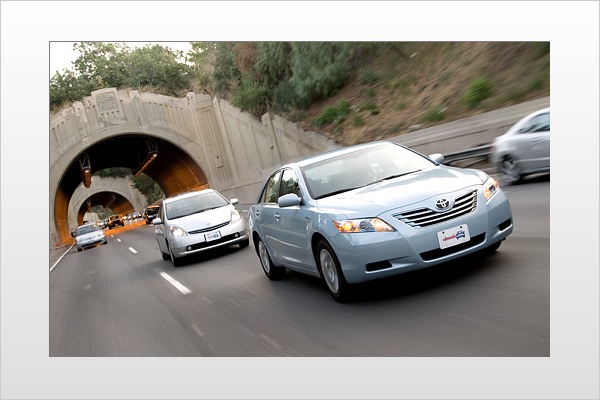
After hearing all the reports of runaway Toyotas and how folks in some cases just couldn't stop the cars, we decided to conduct our own instrumented test. We rounded up a perfectly normal 2010 Toyota Camry SE V6 (one that wasn't subject to the gas-pedal or any other recall) and decided to simulate a few different scenarios, including two involving a runaway car and our attempts to bring it to a relatively swift halt.
Dan Edmunds, our director of automotive testing, took the Camry to our test track where he and Senior Road Test Editor Josh Jacquot conducted three different but related tests. First they ran the Camry through our standard 60-0 braking test to get a baseline stopping distance number. Then, to simulate a runaway car scenario, they ran the same test, but with the throttle held wide open with the driver's right foot. The driver then shifted the automatic transmission from "Drive" to "Neutral" right before applying the brakes with his left foot while the engine continued to rev. The third test also consisted of flooring the throttle, but this time, upon hitting 60 mph Josh mashed the brake pedal down with his left foot while keeping the transmission in "Drive." The latter test was done to determine whether the vehicle's brakes alone could overpower a stuck throttle and bring the car to a relatively swift halt.
As the first test was a standard stopping test, there was no drama — accelerate to 60 then mash the brake pedal. The stopping distance was 119.9 feet.
The second test mimicked what anyone should do if their car's engine unexpectedly races and causes unintended acceleration. And that is to stay calm and quickly put the transmission into Neutral to disengage the racing engine from the drive wheels. This allows you to slow down and stop the car in a semi-normal fashion (albeit with the high-revving engine creating a harmless racket) as the brakes won't be fighting the motive force of a racing engine connected to the drive wheels. The stopping distance was, not surprisingly, essentially the same as the "normal" braking test — 120.5 feet.
The third test simulated a racing engine causing the car to speed out of control and the driver reacting by just hitting the brake pedal as hard as possible. Even though in this case the brakes had to overcome the motive force of the engine, they did. The car came to a halt in 148.8 feet, a distance that perhaps a large, heavy-duty pickup might make under normal maximum braking. With practice (this is, after all, a non-standard test), Josh was able to whittle this distance down to 129 feet. In other words, even if the driver of a runaway car (well, a Camry, anyway) doesn't think to put the transmission into neutral before hitting the brakes, it is still possible to stop the car within a reasonable distance if sufficient pedal force is applied.
The take-away from this is that it is possible to stop a runaway car (or at least a Camry) even if the racing engine is left powering the drive wheels. But to do so takes maximum-effort braking. As this isn't something people practice, they may think they're hitting the brakes hard enough when they're not. To overcome the engine's force, you must stand on the brakes for all you're worth. It's actually worse to just continuously use the brakes moderately hard, as this will not cause the car to stop; instead, the brakes will quickly overheat and fade, becoming ineffective. Think of somebody riding their brakes as they descend a long, steep hill — the telltale smell of burning brakes (and the subsequent fading of their ability) is unmistakable.
Although it is possible to stop a runaway car with a racing engine working against the brakes, we cannot emphasize this enough: Should you find yourself in a runaway car, immediately put the transmission into Neutral and then brake as you normally would to bring the car to a stop as quickly and safely as possible.